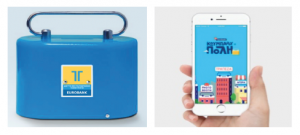By Evy Sakellariou, Keith Goffin, and Agnes Mariakaki
New product development (NPD) is essential to companies and it is an area where our research shows that stories can be a tool to boost creativity. The Storytelling Workshop is an effective but little-known approach used by marketing and innovation practitioners in NPD. Drawing upon their own research, and practical experience working with companies, the authors detail the factors to consider in designing and running storytelling workshops to generate breakthrough product ideas.
“Once upon a time…”
We all remember how stories had the power to delight us as children. Stories touched our emotions, sparked our imagination, and enabled us to make sense of the world, be it “good” or “evil”. In our business lives, stories are somewhat neglected, however, even though they can move us in ways that spreadsheets and powerpoints never will. Too often, stories are perceived to be not useful, invalid, or even not a serious-enough tool for managers.
New product development (NPD) is essential to companies and it is an area where our research shows that stories can be a tool to boost creativity. Innovation is a resource-intensive process but much of the value of NPD investment is lost because more than 75% of new products fail. In some industries, such as food and beverages, the figure is even over 90%. Many studies have shown that the activities that take place at the beginning of new product development are crucial to the success of new products and services. However, this stage where the ideas for new products are generated is perceived as so difficult to manage that it has consequently become known as the fuzzy front-end. The challenge for NPD teams is to design breakthrough products, which offer unique features and provide solutions to customers’ real problems. This requires the generation of new customer insights. So, at the front-end, NPD teams need productive tools for generating insights. Storytelling workshops are an effective but little-known approach.
In this article, we explain how storytelling workshops can be used in NPD. Drawing upon our own research, and practical experience working with companies, we detail the factors to consider in designing and running storytelling workshops to generate breakthrough product ideas.
[ms-protect-content id=”9932″]
Storytelling Workshops
Storytelling workshops are a specific form of co-creation workshops, where NPD team members and customers co-create new product ideas, by sharing experiences and perspectives. The key difference between a storytelling workshop and a conventional co-creation workshop is that the former focusses on generating new knowledge on the problems that customers face with existing products.
New knowledge generation depends on the interplay between explicit knowledge (which is easy to express and document) and tacit knowledge. Therefore, customers are often unable to articulate their needs and are often unaware of the problems they face. Tacit knowledge is difficult to access because it is difficult to express, and linked to individuals’ experiences and unarticulated mental models. Research has shown that the main way in which people share their tacit knowledge is through the use of stories and metaphors. Ironically, a study of new product development teams at leading companies showed that they did not consider stories a worthy way of capturing and sharing knowledge. In contrast, we have found that stories tap the tacit knowledge of our customers (and make managing the front-end less fuzzy).
Storytelling workshops encourage customers and managers to share their experiences of using products as a story, rather than asking them directly to articulate their needs. Analysing the stories which emerge leads to previously unknown customer needs. So, the storytelling idea workshops leverage the rich hidden knowledge that managers and customers have about a particular product or service category. Our research identified six factors to consider in running effective storytelling workshops.
1. Participants and Setting
Relatively small groups of up to six customers and six NPD managers work best, as they allow enough time for everyone to share their stories and interact. Care should be taken when selecting the workshop participants; they should have extensive experience of the product or service category under investigation (either professionally or as a regular user), and they should be willing and capable of sharing experiences and perspectives with others. Customers with in-depth experience of products are more inclined to generate breakthrough ideas than those with less experience.
The choice of the venue is also important. A relaxed environment, rather than a standard conference room, allows the participants to feel at ease, to express themselves without fear of criticism. Plenty of pens, post-its and flipcharts are essential, as is enough wall space to display all of the flipcharts generated in the discussions. Whenever possible, the whole proceeding should be video-recorded using a camera with a wide-angle lens and a good microphone.
Sometimes having an area similar to the customer’s own environment helps. For example, Mölnlycke Heath Care, a leading manufacturer of hospital sterile disposables, has a lock operating theatre at its headquarters which is used for workshops. It is also very useful to have a designer present, who can sketch out product ideas and solutions at the end of the workshop.
2. Facilitation
An experienced and effective facilitator is crucial to storytelling workshops. He or she will need to encourage participants to narrate stories about their experiences with products, particularly unexpected incidents, or ways to resolve product-related problems. The facilitator will need to urge participants to co-create stories and to remind participants that all good stories have a beginning, a plot, and an end but are concise.
Once stories have been told, the facilitator needs to encourage participants to consider what in the story is original thinking (knowledge), particularly where the story identifies previously unknown problems with existing products. Once such problems have been identified, the facilitator can prompt participants to think of metaphors related to how the problems can be solved.
3.Workshop Phases
The main phases of a storytelling workshop are: a) Introductions; b) Sharing stories about using products (capturing notes of each of the stories on a flipchart; c) Discussion of the new thinking that the stories illustrate, with a focus on customers’ problems; d) Group brainstorming of solutions to customers’ problems (using metaphors); e) Initial screening of ideas; f) Crystallisation of ideas to solve customers’ problems and development of new product concepts (with illustrations).
4. Using Stories
In storytelling workshops, customers and NPD managers are encouraged to become narrators. However, our research shows that not all stories are effective. Trigger stories are those that rivet the attention of all participants. They uncover new problems in specific contexts, have condensed plots with engaging and unexpected incidents, and focus on the need to resolve a product-related problem as it is described in the Case study of Eurobank (see Case Study: Storytelling Best Practices at Eurobank). Trigger stories may inspire a sequel and participants to become co-creators. For example, in a storytelling workshop on cleaning products, one mother talked about the problems with how cleaning every time it rains and other participants related to this story strongly.
On the other hand, non-trigger stories lack product-related problems engaging incidents. Consequently, non-trigger stories seldom lead to sequels, co-creation, or breakthrough ideas. Good facilitators can recognise the more mundane stories and focus participants on the more inspiring ones. For example, a story about the (known) problems with a bleach cleaner did not create interest amongst workshop participants.
5. Using Metaphors
Creativity research has stressed the importance of novel thinking, new perspectives, and defining problems and has recommended the use of metaphors. Our research indicates that stories are the more effective mechanism for identifying problems, whereas metaphors are very useful in stimulating ideas for solving problems. Therefore, in storytelling workshops, metaphors are used as part of the brainstorming of solutions to customers’ problems. In response to metaphors, NPD managers can share their technical knowledge on how problems could be solved. Within the context of stories and by linking a product to an unrelated or unfamiliar concept, metaphors help participants to clarify vague or complex problems and new ideas or trigger new stories.
For example, in a storytelling workshop on cleaning products, one participant used the metaphor of a cleaning fluid being like Sherlock Holmes – a detective searching out (and eliminating) germs. This led in the discussion to the idea of a cleaner that changes colour to indicate that germs have been found and eliminated. At this point, a technical expert in the workshop was able to describe a suitable chemical process that would link germ eradication with a change in colour, and the designer quickly sketched a suitable product packaging.
6. Data Analysis
Storytelling workshops produce rich data: multiple flipcharts summarising the stories and the problems they identify; metaphors and ideas of how to solve customers’ problems (including designers’ sketches); and video recordings. The analysis consists of documenting each story including key quotes based on the video recording and flipchart summary; analysing which stories and discussions were only connected with known customer issues and which identified completely new issues. Finally, for the stories connected to known customer issues, the discussions are likely to lead to incremental innovation. In contrast, the stories and metaphors which are linked to previously unknown problems will give ideas for breakthrough innovation.
Too often, new product development teams restrict their thinking to known customer problems and explicit customer requests. This misses the potential to tap customers’ tacit knowledge. Therefore, innovation practitioners need to use storytelling workshops to stimulate the identification of previously unknown customer needs. The stories that customers tell can be shared, as they are an ideal device to share the voice of the customer within companies and are invaluable in new product and new service development. Storytelling workshops can enable executives to challenge existing paradigms, stimulate their creative thinking and take their understanding of customer needs into a fresher and richer perspective.
 Eurobank is a Greek financial services provider that operates successfully in seven countries. In 2014, Eurobank acquired the New TT Hellenic Postbank SA and the New Proton Bank SA. In an effort to understand its customer base and to develop ideas for new digital services, Eurobank held a series of storytelling workshops with customers. Storytelling has enabled Eurobank’s management to hear the authentic voice of its customers and to gather valuable and rich, first-hand customer experiences. Eurobank’s tin piggy bank promotional gift used consistently over several decades was mentioned repeatedly in the stories told by the bank’s customers. Its value as a symbol of prudence was mentioned so often and with such affection that the bank recognised that the piggy bank had become a rite of passage over three generations, used by parents to teach the value of money and saving. So Eurobank decided to capitalise on the traditional piggy bank (in Greek “Koubaras”) as a vehicle to reinforce the Bank’s image as a savings bank. So it took the piggy bank forward to the new digital era through an engaging digital customer experience, which is a tool for parents to teach their children about not only saving but up-to-date financial literacy skills. Eurobank’s Innovation Center initiated the creation of “Koubaroupoli” (city of piggy banks), a mobile app with all the visual elements based on the old tin piggy bank while incorporating interaction with the traditional “koubaras” via Augmented Reality (AR) technology. This service is creating goodwill among customers who are parents and is creating a strong bond with future customers who get to know the value of saving.
Eurobank is a Greek financial services provider that operates successfully in seven countries. In 2014, Eurobank acquired the New TT Hellenic Postbank SA and the New Proton Bank SA. In an effort to understand its customer base and to develop ideas for new digital services, Eurobank held a series of storytelling workshops with customers. Storytelling has enabled Eurobank’s management to hear the authentic voice of its customers and to gather valuable and rich, first-hand customer experiences. Eurobank’s tin piggy bank promotional gift used consistently over several decades was mentioned repeatedly in the stories told by the bank’s customers. Its value as a symbol of prudence was mentioned so often and with such affection that the bank recognised that the piggy bank had become a rite of passage over three generations, used by parents to teach the value of money and saving. So Eurobank decided to capitalise on the traditional piggy bank (in Greek “Koubaras”) as a vehicle to reinforce the Bank’s image as a savings bank. So it took the piggy bank forward to the new digital era through an engaging digital customer experience, which is a tool for parents to teach their children about not only saving but up-to-date financial literacy skills. Eurobank’s Innovation Center initiated the creation of “Koubaroupoli” (city of piggy banks), a mobile app with all the visual elements based on the old tin piggy bank while incorporating interaction with the traditional “koubaras” via Augmented Reality (AR) technology. This service is creating goodwill among customers who are parents and is creating a strong bond with future customers who get to know the value of saving. Note
This article was based on material from the recently published research paper: “Telling tales”: Stories, metaphors and tacit knowledge at the fuzzy front-end of NPD” by Evy Sakellariou, Kalipso Karantinou, Keith Goffin. First published: 22 November 2017 by the Creativity and Innovation Management journal DOI: 10.1111/caim.12237
[/ms-protect-content]
About the Authors
 Evy Sakellariou is Senior Lecturer and MSc Director of Innovation and Entrepreneurship at Kingston University London. Prior to join academia, she held senior managerial roles in marketing and innovation at Unilever UK and Unilever Greece and Cyprus. Her research interests lie in the areas of innovation management and creative leadership.
Evy Sakellariou is Senior Lecturer and MSc Director of Innovation and Entrepreneurship at Kingston University London. Prior to join academia, she held senior managerial roles in marketing and innovation at Unilever UK and Unilever Greece and Cyprus. Her research interests lie in the areas of innovation management and creative leadership.
 Keith Goffin is Adjunct Professor at Stockholm School of Economics and Emeritus Professor of Innovation and New Product Development at Cranfield School of Management. Before joining academia, he worked for fourteen years in the medical electronics industry, in management roles and new product development. His research has been widely published and covers innovation strategy and generating customer insights.
Keith Goffin is Adjunct Professor at Stockholm School of Economics and Emeritus Professor of Innovation and New Product Development at Cranfield School of Management. Before joining academia, he worked for fourteen years in the medical electronics industry, in management roles and new product development. His research has been widely published and covers innovation strategy and generating customer insights.
 Agnes Mariakaki is a Consumer Psychologist, managing MindSearch, a consumer insights company based in Greece. She has developed a series of innovative methodologies exploring the needs and motivations of consumers beyond words. Art, Lego, Improvement theater, Storytelling, Online role play become tools for innovation and new horizons.
Agnes Mariakaki is a Consumer Psychologist, managing MindSearch, a consumer insights company based in Greece. She has developed a series of innovative methodologies exploring the needs and motivations of consumers beyond words. Art, Lego, Improvement theater, Storytelling, Online role play become tools for innovation and new horizons.




































